Durango
by Don Bailey from Don Bailey, State and Federal Copper And Brass Coinage Of Mexico (1824 – 1872), Don Bailey Institute for Mexican Numismatic & Historical research, 2008
There are at least eleven types of state coppers issued from 1824 through 1872.
Eagle & Rays
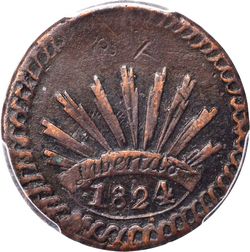
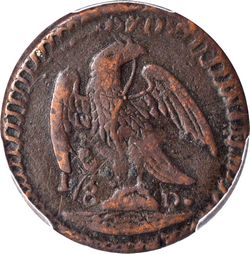
KM 320 ⅛r 1824 D (Stack’s Bowers auction, 22 October 2020, lot 72177)
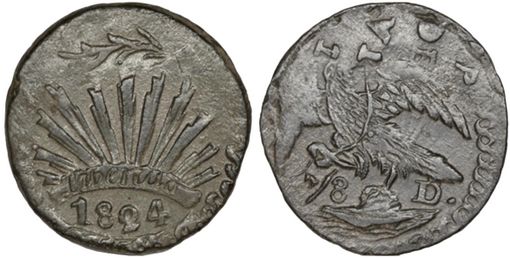
⅛r 1824 D on a ⅛r Nueva Vizcaya host (Briggs & Bustos auction, October 2021, lot 216)
In 1824 the first issue of Durango was of the "Eagle and Rays" style. The ⅛ real issued in 1824 and possibly 1828 has on the obverse the Mexican eagle in an eccentric style with the denomination to the left, and the mintmark "D" or "Do" to the right. The reverse has rays coming from a band with the legend "LIBERTAD". The date is below. Sorne can be found struck over ⅛ reales of 1821 to 1823 from Nueva Vizcaya (later Durango).
The 1824 Durango octavo is an interesting issue to study as it offers insight into coinage practices of the early republic. This was the first state issue to be produced under the authorization of the new Mexican constitution of 1824. The Durango mint had earlier experience with copper issues with the municipal issue of 1812-18, and the Nueva Vizcaya issues of 1821-23, which incidentally had little to do with the Empire of Iturbide. The sheer number of different die varieties clearly indicates a very large mintage. Style differences are also present, evidently resulting from workers with varying abilities or motivation.
Bailey looked at some possibilities to divide the 1824 mintage into smaller, more workable subgroups. Sorne possibilities are:
1. Wing configuration of eagle
a. Blunt right wing, most with 11 rays on reverse but also with 9 rays
b. Flat section on right wing, most with 12 rays
c. Reverse with rough right wing, includes partial wing, most with 11 rays
Each wing appears to be made from individual punches, as are various other eagle and numeric features. Wing placement may vary slightly on the body and may be used in various combinations with other eagle parts.
2. Progression of deterioration of the Libertad banner
3. Number of rays from the Libertad banner, 9-10-11-12
All variant types appear to be found with and without Nueva Vizcaya under coin, seemingly at random. The overstriking has resulted in unusual border combinations including denticled, cordate or combined and most often, no border at all. Most have diagonal edge reeding. We wonder if it is at least partially the result of the origÍnal reeding on the Nueva Vizcaya undercoin or if it was applied at the striking of the Durango coin, or both. Most obvious counterfeits, but not all, lack edge reeding and are sometimes irregular in shape and thickness. Sorne well made specimens appear to have hand reeding or no reeding at all.
| KM 320 | eagle & rays | 1824 | 19mm | no overstrike |
| 1824 | Struck over Nueva Vizcaya octavo | |||
| 1824 | Struck over Nueva Vizcaya cuartilla | |||
| KM 320a | 1828 | Likely a circulating counterfeit |
Indian and Tree


KM 321 ⅛r 1828 Do (Stack’s Bowers auction, 23 October 2019, lot 72564)
The next design issued in 1828 in ⅛ real denomination only is known as the "Indian and Tree" style. The obverse has an Indian holding a bow and arrow with an apparent flowing trunk of a tree. The reverse has the liberty cap design with the legend "OCTo DE R.DE Do 1828".
| KM 321 | Indian and tree | 1828 | 18mm |
Circle and Wreath
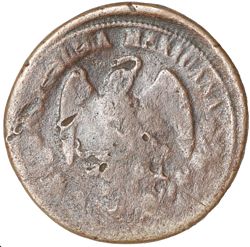
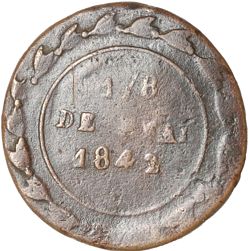
KM 323 ¼ real 1860 Durango (Briggs & Bustos auction, 3 September 2023, lot 40)
The "Circle and Wreath" design was issued in 1833 and 1842. The ⅛ real obverse has the Mexican eagle in a style peculiar to Durango, with the legend "REPUBLICA MEXICANA". The reverse has within a circle and wreath, the date and denomination. There is an absence of a mintmark on this style.
The 1842 ⅛ real is most interesting, in that it is the only state issue that does not show its place of origin. In fact, for many years it was thought to be a Mexico City issue. However, although this coin shows neither DURANGO nor a Durango mintmark the obverse has the same die as the 1 real silver French die. The reverse is the same as the preceding Durango coin. It is believed that it was created to overstrike much of the federal government coinage that was to be removed from circulation, thus circumventing a mandated amortization. The amortized copper would have been a loss to the Durango treasury. By over striking the federal issues and returning them to circulation, no loss was incurred.
A Durango ¼ real dated 1845 is probably a pattern. This piece is known only from the T.V. Buttrey's Guide Book of Mexican Coins illustration, which was obtained from a Neil Utberg photo from a Mexican collection. The whereabouts are unknown today. The coin is likely unique.
| KM 322 | ESTADO DE DURANGO | 1833 | 20mm | |
| KM 323b | 1833 | 19mm | ||
| KM 323 | 1842/33 | |||
| 1842 | large date | |||
| small date |
"Large Numeral"
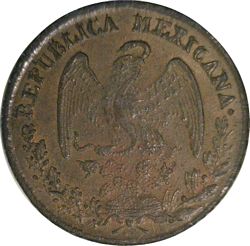

KM 325
During 1845 through 1847, 1851 and 1852 the "Large Numeral" style was issued. The ⅛ real denomination had the obverse of the one real silver coins of Durango. The reverse has in a center circle a large 8o, (octavo) with the legend around,"DEPARTAMENTO DE DURANGO" in 1845 and 1847, and "ESTADO DE DURANGO" in 1851 and 1852. The date is below.
The 1854 ⅛ real DEPARTAMENTO listed in some catalogs probably do not exist but are examples of 1851's which have large serifs on the 1 that became flat with wear. No unworn example of an 1854 date is known. An issue thought by some collectors to be various overdates is a 1853 with an upside down 3. This is a likely circulating counterfeit.
| KM 324 | DEPARTAMENTO DE DURANGO | 1845 | 19mm | |
| 1846 | ||||
| 1847 | ||||
| KM 325 | ESTADO DE DURANGO | 1851 | ||
| 1851 | Rounded wing Mexican eagle, ornaments under ‘O’ missing. Plain edge. Likely a circulating counterfeit. | |||
| 1852 | ||||
| 1852/1 | ||||
| 1853 | Inverted 3 |
Wreathless
The 1858 coinage was ordered by Coronel Esteban Coronado[text needed] as a forced loan of $40,000 from the Diocese of Durango.
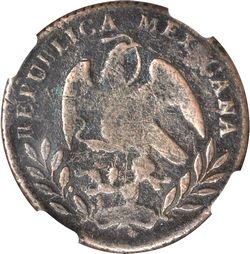
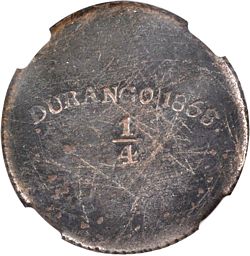
KM 346 ¼r 1858 Durango (Stack’s Bowers Baltimore auction, November 2015, lot 42398)
In 1858 there was a ¼ real issue commonly called the "Wreathless" style. It had the standard Mexican eagle obverse, but the reverse has only the inscription, "Durango, 1858" and "¼ ".
| KM 346 | REPUBLICA MEXICANA | 1858 | 27mm |
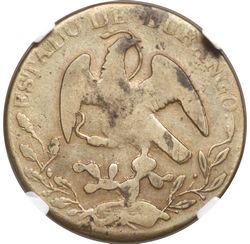
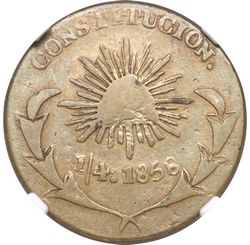
KM 347 brass ¼r 1858 Durango (Heritage auction, 13 January 2016, lot 34483)
Also issued in 1858 is a type with "CONSTITUCION" above a Liberty Cap and below is "¼" and the date "1858" and two branches.
| KM 347 | CONSTITUCION | 1858 | 27mm | copper |
| brass |
On 17 May 1859 José Antonio Heredia ordered the minting of 10,000 cuartillas.
Circular Wreath
The 1860 issue was ordered by General Domingo Cajén[text needed}.
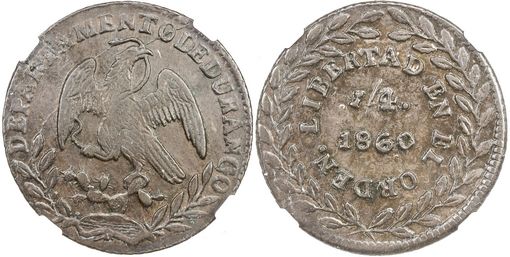 KM 348 ¼ real 1860 Durango (Stephen Album Rare Coins auction #40, 13 May 2021, lot 1759 )
KM 348 ¼ real 1860 Durango (Stephen Album Rare Coins auction #40, 13 May 2021, lot 1759 )
The next issue was the "Circular Wreath", dated 1860 and 1866, which was struck in the 1/4 real denomination. The obverse has the national emblem and the inscription, "DEPARTAMENTO DE DURANGO." The reverse has within a wreath the denomination, the date and the legend, "LIBERTAD EN EL ORDEN".
| KM 348 | DEPARTAMENTO DE DURANGO |
1860 | 27mm | |
| 1866 |
INDEPENDENCIA Y LIBERTAD

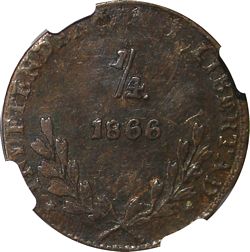
KM 349
The second issue of 1866 is of ¼ real denomination with the Mexican eagle obverse and the legend, "ESTADO DE DURANGO". The reverse has the ¼ real denomination and the 1866 date in the center over two laurel branches and the legend above, "INDEPENDENCIA Y LIBERTAD".
The 1866 coinage was authorised by the governor, Silvestre Aranda[text needed} during Benito Juaréz stay in the city. This was to be an affront to the Maximilian Empire, then in power in Mexico City.
| KM 349 | ESTADO DE DURANGO | 1866 | 27mm | dot after date |
| without dot after date |
SUFRAGIO LIBRE
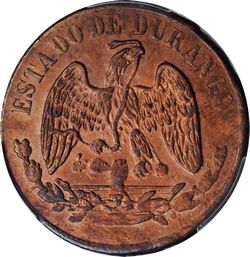

KM 350 ¼r 1872 Durango (Stack’s Bowers auction, 24 June 2021, lot 72365)
The final issue from the Durango mint was in 1872 by a rebel movement. The reelection in 1871 of Benito Juárez was declared fraudulent by Porfirio Díaz, a popular candidate for the same office. In response to this, Donato Guerra, a supporter of Díaz, overran much of Durango and Chihuahua, and held these areas until the death of Juárez in the middle of 1872. In the city of Durango, the governor of the time, Juan Hernández y Marín, was forced to abandon the state capital and leave power in the hands of General Tomás Borrego, who by decree on [ ][text needed] ordered a ¼ real coin to be minted in the capital's mint. The decimal system was already in force so the ¼ real denomination was improper. This coin used the basic eagle device from the $10 gold for the obverse, with the legend "ESTADO DE DURANGO". The reverse has within a laurel wreath, the ¼ real denomination, the date, 1872 and the legend "SUFRAGIO LIBRE", which represented represented anti- reelection and anti- Juárez sentiment.
Upon Juárez's death, Díaz relinquished his claim on the presidency and his supporters abandoned the conquered territory. On 20 May 1872, General Sóstenes Rocha arrived in Durango to remove the insurgents from the government of the capital and the state, accompanied by the second military division, and to recover the city. SUFRAGIO LIBRE cuartillas are commonly found with the countermark "R" that is thought to be a revalidation by Rocha. At least two different styles of "R" countermarks are found.

KM 350 ¼r 1872 Durango with R countermark (Del Bosque, Briggs & Bustos auction #13, 16 April 2021, lot 366)
| KM 350 | SUFRAGIO LIBRE | 1872 | 27mm | copper |
| brass | ||||
| ‘R’ counterstamp |
The early issues of 1824 - 1845 have an obliquely reeded edge while the later issues from 1845 on have an edge with an are and dot pattem.
Mintages
| ⅛ real No. of coins |
¼ real No of coins |
Total value | |
| 1846-1847 | 80,000 | $20,000.00 |
